Bandolier Equipment, Pattern 1903 - Cartridge Pockets
Pocket, cartridge, 15 rounds. (Mark I.)
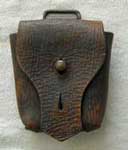
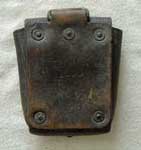
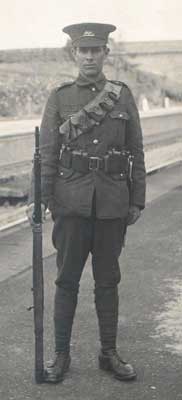 The Pocket, cartridge, 15 rounds (Mark I) was introduced with the Pattern 1903 Bandolier Equipment in List of Changes entry §12389, dated 20th October 1903. It is similar to the 10 round Pocket but is more square in shape, has two stud holes on its flap, and has a brass "dee" on the top rear to take the front hook of the Greatcoat carrier. It is designed to hold 15 rounds of .303-inch ammunition in three 5 round chargers. The Mk. I 15 Round cartridge pocket was superseded by the Mk. II version in List of Changes entry §13273, dated. 27th November 1905 / 26 January 1906. This early example is maker marked "T.C. GALLEY" and dated 1903. From the Karkee Web Collection.
The Pocket, cartridge, 15 rounds (Mark I) was introduced with the Pattern 1903 Bandolier Equipment in List of Changes entry §12389, dated 20th October 1903. It is similar to the 10 round Pocket but is more square in shape, has two stud holes on its flap, and has a brass "dee" on the top rear to take the front hook of the Greatcoat carrier. It is designed to hold 15 rounds of .303-inch ammunition in three 5 round chargers. The Mk. I 15 Round cartridge pocket was superseded by the Mk. II version in List of Changes entry §13273, dated. 27th November 1905 / 26 January 1906. This early example is maker marked "T.C. GALLEY" and dated 1903. From the Karkee Web Collection.
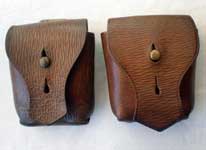 Additional examples of the Pocket, cartridge, 15 rounds, (Mark I). The Pocket at far left is maker marked "Middlemore & Lamplugh Ld | Birmingham" and dated 1905. Usage marks are "2/06 | C.M.F | W | S.A. | 11/12". The Pocket near left is maker marked "J. Noake & Son | Walsall" and dated 1904. Usage marks for both Pockets are identical and read "2/06 | C.M.F | W | S.A. | 11/12".
Additional examples of the Pocket, cartridge, 15 rounds, (Mark I). The Pocket at far left is maker marked "Middlemore & Lamplugh Ld | Birmingham" and dated 1905. Usage marks are "2/06 | C.M.F | W | S.A. | 11/12". The Pocket near left is maker marked "J. Noake & Son | Walsall" and dated 1904. Usage marks for both Pockets are identical and read "2/06 | C.M.F | W | S.A. | 11/12".
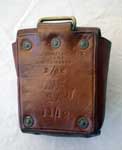
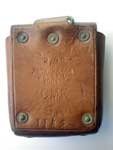
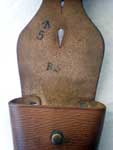 Rear views of the two Pockets shown above, as well as an internal view showing an inspection mark. Both are from the Dan Irving Collection, photos © Dan Irving 2017. Although the Fitting Instructions for Bandolier Equipment, Pattern 1903, called for two 15 round and two 10 round Cartridge pockets to be worn, judging from contemporary photographs it seems to have been common practice to replace the 10 round Pockets with two additional 15 round ones, as seen in the photograph on the right.
Rear views of the two Pockets shown above, as well as an internal view showing an inspection mark. Both are from the Dan Irving Collection, photos © Dan Irving 2017. Although the Fitting Instructions for Bandolier Equipment, Pattern 1903, called for two 15 round and two 10 round Cartridge pockets to be worn, judging from contemporary photographs it seems to have been common practice to replace the 10 round Pockets with two additional 15 round ones, as seen in the photograph on the right.
Pocket, cartridge, 15 rounds. (Mark I.) - Late Production (Territorial Force?)
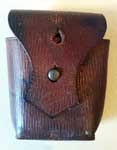
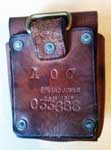 This Pocket, cartridge, 15 rounds, (Mark I) exhibits an unexpected feature - the tab securing the brass loop is turned inwards, whilst a normal Mk. I has the tab turned outwards, with the end sandwiched between the rear panel and the front flap. Even more interesting is the late production date - why were they making Mk. I Pockets in 1914, eight years after they were superseded by the Mk.II? We can only speculate. It seems unlikely that this obsolete form was intended for the regular army; we believe a more reasonable suggestion is that this was intended for Volunteer/Territorial Force use. We know that these units had considerable latitude in the way they were equiped, and some wild and wonderful variations of B.E. Patt. '03 are sometimes seen in period photographs. It might have been simply a local choice, but one possible clue can be gained from the 1910 Priced Vocabulary of Stores. In that listing, the cost of a Pocket, cartridge, 15 rounds, (Mark I) is given as 8d, while the cost of a Mk. II is 8½d. These units had to purchase their accoutrements, using grants from their County Territorial Associations who, in turn, were funded by the War Office. The T.F. therefore had to eke out their funds more carefully than the Regular Army. Ha'pennies add up, and that savings alone could have been sufficient justification for its use. The Pocket is maker marked "Edward Jones | C&M 1914" and dated 1914. It is also marked "A O C | 033688." From the Karl Vines Collection, photos © Karl Vines 2017.
This Pocket, cartridge, 15 rounds, (Mark I) exhibits an unexpected feature - the tab securing the brass loop is turned inwards, whilst a normal Mk. I has the tab turned outwards, with the end sandwiched between the rear panel and the front flap. Even more interesting is the late production date - why were they making Mk. I Pockets in 1914, eight years after they were superseded by the Mk.II? We can only speculate. It seems unlikely that this obsolete form was intended for the regular army; we believe a more reasonable suggestion is that this was intended for Volunteer/Territorial Force use. We know that these units had considerable latitude in the way they were equiped, and some wild and wonderful variations of B.E. Patt. '03 are sometimes seen in period photographs. It might have been simply a local choice, but one possible clue can be gained from the 1910 Priced Vocabulary of Stores. In that listing, the cost of a Pocket, cartridge, 15 rounds, (Mark I) is given as 8d, while the cost of a Mk. II is 8½d. These units had to purchase their accoutrements, using grants from their County Territorial Associations who, in turn, were funded by the War Office. The T.F. therefore had to eke out their funds more carefully than the Regular Army. Ha'pennies add up, and that savings alone could have been sufficient justification for its use. The Pocket is maker marked "Edward Jones | C&M 1914" and dated 1914. It is also marked "A O C | 033688." From the Karl Vines Collection, photos © Karl Vines 2017.
Pocket, cartridge, 15 rounds. (Mark II.)
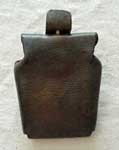
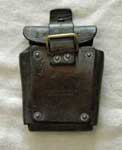 The Pocket, cartridge, 15 rounds, (Mark II) replaced the Mk. I Cartridge pocket in List of Changes entry §13273, dated. 27th November 1905 / 26th January 1906. It is identical to the Mk. I except for the closure. Instead of a large flap, this version has only a small flap that is closed by a strap sewn to the rear. This example is maker marked "ALMOND & SMITH / C & M" and is dated 1906. As an aside, C & M stands for Currier & Manufacturer, i.e. someone who prepares leather from tanned hides, not just someone who buys in already prepared leather. From the Karkee Web Collection.
The Pocket, cartridge, 15 rounds, (Mark II) replaced the Mk. I Cartridge pocket in List of Changes entry §13273, dated. 27th November 1905 / 26th January 1906. It is identical to the Mk. I except for the closure. Instead of a large flap, this version has only a small flap that is closed by a strap sewn to the rear. This example is maker marked "ALMOND & SMITH / C & M" and is dated 1906. As an aside, C & M stands for Currier & Manufacturer, i.e. someone who prepares leather from tanned hides, not just someone who buys in already prepared leather. From the Karkee Web Collection.
Pocket, cartridge, 15 rounds, Territorial Force
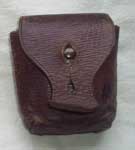
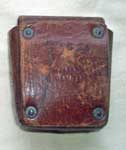
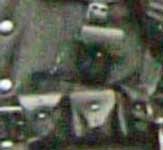 From the front, this appears to be a perfectly normal Pocket, cartridge, 15 rounds, (Mark I) for the Bandolier Equipment, Pattern 1903. One look from the rear, though, reveals just how special this one is. Compared with the standard Mk. I Pocket shown above, one can see that both the brass dee and the rivet in the top centre have been omitted. The reason is shown in the detail at right. Many Territorial Force units went to great lengths to upgrade their B.E., Patt. '03, adding Packs, Entrenching tool carriers, etc. One variation occasionally seen in pictures is the pattern of four 15-round Cartridge pockets on each side, arranged in a "one-over-three" symmetrical pattern. This gave a total ammunition load of 120 rounds. The centre pocket is the standard Mk. I, while the other three would be the type shown here. Without the dee and central rivet, the Pocket can be worn either with the Belt passed horizontally through it, or vertically on a Brace. Close examination of this example, in fact, reveals wear marks indicating that it has in fact been worn both ways. This Pocket is maker marked "EDWARD JONES / C & M" and dated 1909. From the Steve Hewitt collection, photos © Steve Hewitt 2009.
From the front, this appears to be a perfectly normal Pocket, cartridge, 15 rounds, (Mark I) for the Bandolier Equipment, Pattern 1903. One look from the rear, though, reveals just how special this one is. Compared with the standard Mk. I Pocket shown above, one can see that both the brass dee and the rivet in the top centre have been omitted. The reason is shown in the detail at right. Many Territorial Force units went to great lengths to upgrade their B.E., Patt. '03, adding Packs, Entrenching tool carriers, etc. One variation occasionally seen in pictures is the pattern of four 15-round Cartridge pockets on each side, arranged in a "one-over-three" symmetrical pattern. This gave a total ammunition load of 120 rounds. The centre pocket is the standard Mk. I, while the other three would be the type shown here. Without the dee and central rivet, the Pocket can be worn either with the Belt passed horizontally through it, or vertically on a Brace. Close examination of this example, in fact, reveals wear marks indicating that it has in fact been worn both ways. This Pocket is maker marked "EDWARD JONES / C & M" and dated 1909. From the Steve Hewitt collection, photos © Steve Hewitt 2009.
Pocket, cartridge, 10 rounds. (Mark I)
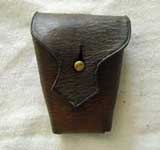
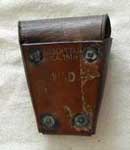 The Pocket, cartridge, 10 rounds. (Mark I) was introduced with the Pattern 1903 Bandolier Equipment in List of Changes entry L. of C. §12389, dated 20th October 1903. It has a loop on the rear so that it can slide onto the Waist belt, and will accept ten rounds of .303-inch ammunition in two 5 round chargers. It remained unchanged throughout its service life. This example is Australian, and is Maker marked "ROSENSTAM / WA" and dated 1916. From the Karkee Web Collection.
The Pocket, cartridge, 10 rounds. (Mark I) was introduced with the Pattern 1903 Bandolier Equipment in List of Changes entry L. of C. §12389, dated 20th October 1903. It has a loop on the rear so that it can slide onto the Waist belt, and will accept ten rounds of .303-inch ammunition in two 5 round chargers. It remained unchanged throughout its service life. This example is Australian, and is Maker marked "ROSENSTAM / WA" and dated 1916. From the Karkee Web Collection.
Pocket, cartridge, 10 round (Cadet, or Territorial Force?)
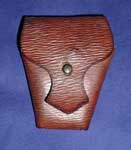

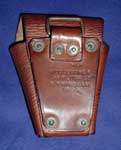 It is always very gratifying when something you have never seen, but knew had to exist, turns up at last. This was the case when Steve Hewitt sent Karkee Web the pictures of his T.F. variation of the Pocket, cartridge, 15 rounds, (Mark I) shown above. It is even more exhilarating when something totally unexpected suddenly appears. This is the case with this variation of the Pocket, cartridge, 10 rounds, (Mark I), complete with a brass loop on the rear! No one on the Karkee Web team has seen one of these, or even suspected that such a thing existed. It does exist, though, and it is unquestionably genuine.
It is always very gratifying when something you have never seen, but knew had to exist, turns up at last. This was the case when Steve Hewitt sent Karkee Web the pictures of his T.F. variation of the Pocket, cartridge, 15 rounds, (Mark I) shown above. It is even more exhilarating when something totally unexpected suddenly appears. This is the case with this variation of the Pocket, cartridge, 10 rounds, (Mark I), complete with a brass loop on the rear! No one on the Karkee Web team has seen one of these, or even suspected that such a thing existed. It does exist, though, and it is unquestionably genuine.
No such Pocket was listed for the Regular Army and, to emphasise this, the brass loop designs (the Mk. I was slightly larger than Mark II loop) are specifically listed only for the 15 round Pockets. Therefore, we can only speculate on its intended user. Possibly, like the 15-round Pocket previously mentioned, it was meant for Territorial Force use. Many of the T.A. units went to elaborate lengths to upgrade and customize their Patt. '03 equipment, to emulate the greater ammunition capacity of the Regular Army’s new Pattern 1908 W.E..
As early as 1904, one Regular Army unit was photographed with four 15 round Pockets, the 10 round ones having been abandoned. Other units did the same, so for a T.A. unit to procure this special design - of smaller capacity - would seem perverse. It is possible that the specials were for Field Days / Manoeuvres, which would seem a financial indulgence, if “normal” 10, plus the 15 round Pockets were also in their unit inventory.
It is however plausible that a unit, who routinely carried less ammunition, would wish to move the brass loop from the regulation 15 round Pocket. Cadet and O.T.C. units would have little opportunity to require carrying capacity for 100 rounds. It is far more likely that they would only ever carry 20 rounds and blank ammunition at that! Since they would still need to attach the shoulder straps of the Great coat carrier, loops would be required on the smaller of the B.E. Pocket designs.
All of this is pure speculation and, needless to say, any hard information, or period photos of a Pocket like this in use will be eagerly received. On the inside of the flap is written "CARTIDGE (sic) HOLDER PICKED UP ON BEACH AT DARD'LS". It is also lightly stamped to the 5th Batt. N.F. The 5th Battalion of the Northumberland Fusiliers were at Gallipoli, so that makes sense. The Pocket is maker marked "MIDDLEMORE & / LAMPLUGH LD / BIRMINGHAM" and dated 1909. From the Chris Cutting Collection, photos © Chris Cutting 2009.


 The Pocket, cartridge, 15 rounds (Mark I) was introduced with the Pattern 1903 Bandolier Equipment in List of Changes entry §12389, dated 20th October 1903. It is similar to the 10 round Pocket but is more square in shape, has two stud holes on its flap, and has a brass "dee" on the top rear to take the front hook of the Greatcoat carrier. It is designed to hold 15 rounds of .303-inch ammunition in three 5 round chargers. The Mk. I 15 Round cartridge pocket was superseded by the Mk. II version in List of Changes entry §13273, dated. 27th November 1905 / 26 January 1906. This early example is maker marked "T.C. GALLEY" and dated 1903. From the Karkee Web Collection.
The Pocket, cartridge, 15 rounds (Mark I) was introduced with the Pattern 1903 Bandolier Equipment in List of Changes entry §12389, dated 20th October 1903. It is similar to the 10 round Pocket but is more square in shape, has two stud holes on its flap, and has a brass "dee" on the top rear to take the front hook of the Greatcoat carrier. It is designed to hold 15 rounds of .303-inch ammunition in three 5 round chargers. The Mk. I 15 Round cartridge pocket was superseded by the Mk. II version in List of Changes entry §13273, dated. 27th November 1905 / 26 January 1906. This early example is maker marked "T.C. GALLEY" and dated 1903. From the Karkee Web Collection. Additional examples of the Pocket, cartridge, 15 rounds, (Mark I). The Pocket at far left is maker marked "Middlemore & Lamplugh Ld | Birmingham" and dated 1905. Usage marks are "2/06 | C.M.F | W | S.A. | 11/12". The Pocket near left is maker marked "J. Noake & Son | Walsall" and dated 1904. Usage marks for both Pockets are identical and read "2/06 | C.M.F | W | S.A. | 11/12".
Additional examples of the Pocket, cartridge, 15 rounds, (Mark I). The Pocket at far left is maker marked "Middlemore & Lamplugh Ld | Birmingham" and dated 1905. Usage marks are "2/06 | C.M.F | W | S.A. | 11/12". The Pocket near left is maker marked "J. Noake & Son | Walsall" and dated 1904. Usage marks for both Pockets are identical and read "2/06 | C.M.F | W | S.A. | 11/12". 

 Rear views of the two Pockets shown above, as well as an internal view showing an inspection mark. Both are from the Dan Irving Collection, photos © Dan Irving 2017. Although the Fitting Instructions for Bandolier Equipment, Pattern 1903, called for two 15 round and two 10 round Cartridge pockets to be worn, judging from contemporary photographs it seems to have been common practice to replace the 10 round Pockets with two additional 15 round ones, as seen in the photograph on the right.
Rear views of the two Pockets shown above, as well as an internal view showing an inspection mark. Both are from the Dan Irving Collection, photos © Dan Irving 2017. Although the Fitting Instructions for Bandolier Equipment, Pattern 1903, called for two 15 round and two 10 round Cartridge pockets to be worn, judging from contemporary photographs it seems to have been common practice to replace the 10 round Pockets with two additional 15 round ones, as seen in the photograph on the right.
 This Pocket, cartridge, 15 rounds, (Mark I) exhibits an unexpected feature - the tab securing the brass loop is turned inwards, whilst a normal Mk. I has the tab turned outwards, with the end sandwiched between the rear panel and the front flap. Even more interesting is the late production date - why were they making Mk. I Pockets in 1914, eight years after they were superseded by the Mk.II? We can only speculate. It seems unlikely that this obsolete form was intended for the regular army; we believe a more reasonable suggestion is that this was intended for Volunteer/Territorial Force use. We know that these units had considerable latitude in the way they were equiped, and some wild and wonderful variations of B.E. Patt. '03 are sometimes seen in period photographs. It might have been simply a local choice, but one possible clue can be gained from the 1910 Priced Vocabulary of Stores. In that listing, the cost of a Pocket, cartridge, 15 rounds, (Mark I) is given as 8d, while the cost of a Mk. II is 8½d. These units had to purchase their accoutrements, using grants from their County Territorial Associations who, in turn, were funded by the War Office. The T.F. therefore had to eke out their funds more carefully than the Regular Army. Ha'pennies add up, and that savings alone could have been sufficient justification for its use. The Pocket is maker marked "Edward Jones | C&M 1914" and dated 1914. It is also marked "A O C | 033688." From the Karl Vines Collection, photos © Karl Vines 2017.
This Pocket, cartridge, 15 rounds, (Mark I) exhibits an unexpected feature - the tab securing the brass loop is turned inwards, whilst a normal Mk. I has the tab turned outwards, with the end sandwiched between the rear panel and the front flap. Even more interesting is the late production date - why were they making Mk. I Pockets in 1914, eight years after they were superseded by the Mk.II? We can only speculate. It seems unlikely that this obsolete form was intended for the regular army; we believe a more reasonable suggestion is that this was intended for Volunteer/Territorial Force use. We know that these units had considerable latitude in the way they were equiped, and some wild and wonderful variations of B.E. Patt. '03 are sometimes seen in period photographs. It might have been simply a local choice, but one possible clue can be gained from the 1910 Priced Vocabulary of Stores. In that listing, the cost of a Pocket, cartridge, 15 rounds, (Mark I) is given as 8d, while the cost of a Mk. II is 8½d. These units had to purchase their accoutrements, using grants from their County Territorial Associations who, in turn, were funded by the War Office. The T.F. therefore had to eke out their funds more carefully than the Regular Army. Ha'pennies add up, and that savings alone could have been sufficient justification for its use. The Pocket is maker marked "Edward Jones | C&M 1914" and dated 1914. It is also marked "A O C | 033688." From the Karl Vines Collection, photos © Karl Vines 2017. 
 The Pocket, cartridge, 15 rounds, (Mark II) replaced the Mk. I Cartridge pocket in List of Changes entry §13273, dated. 27th November 1905 / 26th January 1906. It is identical to the Mk. I except for the closure. Instead of a large flap, this version has only a small flap that is closed by a strap sewn to the rear. This example is maker marked "ALMOND & SMITH / C & M" and is dated 1906. As an aside, C & M stands for Currier & Manufacturer, i.e. someone who prepares leather from tanned hides, not just someone who buys in already prepared leather. From the Karkee Web Collection.
The Pocket, cartridge, 15 rounds, (Mark II) replaced the Mk. I Cartridge pocket in List of Changes entry §13273, dated. 27th November 1905 / 26th January 1906. It is identical to the Mk. I except for the closure. Instead of a large flap, this version has only a small flap that is closed by a strap sewn to the rear. This example is maker marked "ALMOND & SMITH / C & M" and is dated 1906. As an aside, C & M stands for Currier & Manufacturer, i.e. someone who prepares leather from tanned hides, not just someone who buys in already prepared leather. From the Karkee Web Collection.






